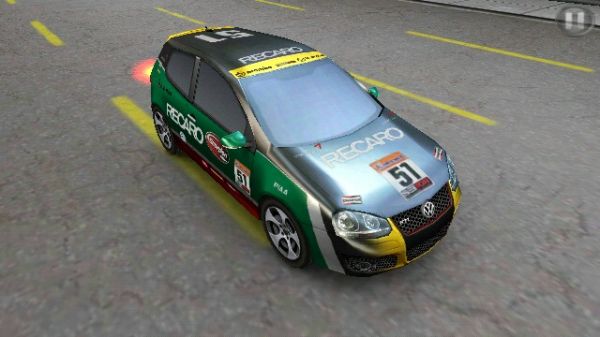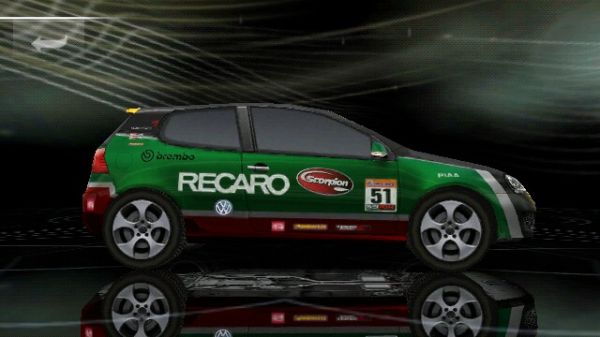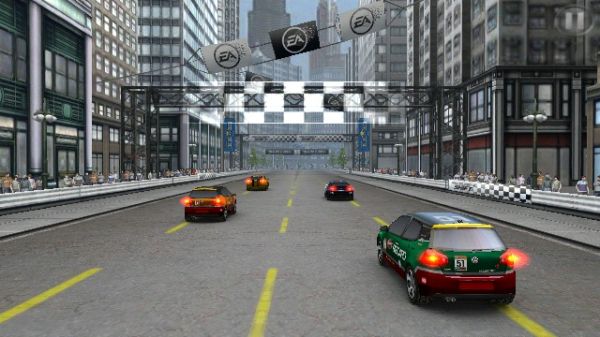Nokia N8 Review: Nokia's New Flagship
by Mithun Chandrasekhar on January 12, 2011 1:00 AM EST- Posted in
- Smartphones
- Nokia
- N8
- Symbian
- Mobile
Look who’s calling the shots…
The N8 represents many firsts for Nokia. It is the first phone to be based on the Symbian^3 platform. It is the first Nokia phone to carry a 12MP camera sensor. It is also the first Nokia phone to have a discrete GPU. And finally, it is the first mainstream Nokia phone to be multi-touch capable (and just the 2nd to have a capacitive screen) and have a GPU accelerated UI, both of which are as a result of switching to Symbian^3. And when it comes to the display and what’s driving it, the Nokia N8 doesn’t disappoint.


NFS Shift HD running on the BMC2727 in the Nokia N8
While I’ll get to the biggest change in the N8 that is the Symbian^3 OS in a while, Nokia has also updated what’s calling the shots behind the scenes. Up until Symbian^3 came along, Nokia rarely ever bothered with including a GPU in its phones and even when it did, it was never really put to any good use. Its last N-Series flagship, the N97, didn’t even have a GPU per se. Except for the Cortex A8-touting outlier that the N900 is, the best that Nokia has done in terms of integrating GPU’s into phones is make use of the OMAP 2420 SoC, which included a PowerVR MBX GPU, in a handful of its previous devices and even this was left mostly unutilized. Things have changed, for the better, with the Nokia N8. Although Nokia is still sticking with a tried and tested ARM 11 implementation for its CPU, it has actually gone ahead and made full use of a discrete Broadcom BCM2727 Multimedia processor for graphic duties. While you can see performance numbers later in the review, the general impression is that it is fairly competent as a GPU.
Nokia’s choice of using an aged ARM 11 implementation, down-clocked to 680 Mhz (instead of the spec’d 772 Mhz) for its CPU may draw criticism in this day and age of gigahertz-capable, multi-core mobile SoC’s. But digging a little deeper seems to show that there may be some method to this madness. You see, pretty much everything in the N8 runs around the BCM2727 media processor. I would hazard a calculated guess that apart from lightweight low-level OS functions and interfacing with the baseband and other radio’s, there isn’t much else for the CPU to do on the N8. Plus, Symbian’s inherently efficient use of available resources helps too.
So what was needed in this case was a low-power, package efficient CPU design that could just about get the job done while sipping as little power and occupying as little space as possible. And this is almost exactly what Nokia found in the Samsung K5WXXXXXXX series of Fusion Memory MCP’s. This MCP (Multi Chip Package) allows Samsung to stack different memory types (DDR, NAND etc.) along with non-memory logic in the same low-power package. So for basically the same footprint as a single memory chip, Samsung is able to integrate the DDR memory (256MB), NAND (512MB) and a CPU (TI ARM11 applications processor).
Most of the heavy lifting in the N8 is done by the BCM2727, as it renders the Symbian^3 UI and games alike, works with the camera module to capture and process 12MP stills and 720p videos, encodes/decodes those videos, drives the HDMI output (upto 720p) and even decodes the audio. So in case of the N8 and Symbian^3, it made sense for Nokia to have a low-power ARM11 CPU coupled with a reasonably powerful and competent multimedia processor. Using an A8 Cortex-based 1Ghz+ part here to run Symbian^3 would have been overkill and power-inefficient. And this decision is quite obvious when you use the N8. The UI is very fluid and responsive with crisp transitions and swift app switching. Furthermore, the N8 posted very competitive battery life numbers to further substantiate Nokia’s decision here.












119 Comments
View All Comments
sumeetm90 - Sunday, January 16, 2011 - link
I have been using N8 for a month now and have discovered following pesky issues:1) You cant mark multiple messages in your inbox. If you want to delete say 10 messages in a go you need to individually delete them. (Dont understand how can nokia make such a blunder)
2) Cannot utilize full screen to view pdf documents in Adobe reader provided by nokia. This is really ridiculous. You are forced to use 75% of the available screen to read pdfs.
3) I was surprised to find that there was no stopwatch feature included with the new phone. Yes you can download an app but when I pay Indian rupees 23600 (approx $500) for a smartphone, I expect nokia to put a stopwatch/countdown timer in phone.
4) You need to download a scientific calculator. The default calculator is pretty lame and embarrassing. If you search the ovi store you will realise it is not so easy to download a scientific calculator.
I gotta agree with Mithun about the issues with browser, mail application and ovi store. I have been a vivid Nokia fan and thats why I bought N8. But clearly nokia has lot of issuses to address. I cant recommend this phone to my friends. Lets hope nokia is listening and comes up with a descent update soon.
Johnmcl7 - Sunday, January 16, 2011 - link
Nokia have a licensing agreement to stick the Zeiss name on their phones, that's all there is to it as the lenses most certainly are not a Zeiss design by any stretch of the imagination despite the laughable 'Tessar' branding on some of them.Voldenuit - Sunday, January 16, 2011 - link
That doesn't mean that Zeiss does not have a say on which lenses their branding goes on and provide input on lens designs etc.This is very similar to the arrangement Panasonic have with Leica - Panasonic design and manufacture the lenses themselves, but Leica has the final say on whether or not the lens is good enough to receive their branding. In fact, while my Leica R4 had genuine Leica lenses, the body itself was a copy of a Minolta SLR, so Leica branding has been a 2-way street.
Similarly, the Sony Alpha Zeiss and compact camera lenses are designed and built by Sony. And my Pentax SMC Takumar (ca. 1970) was manufactured by Asahi Optical Company. This is not news, it's been the modus operandi of the camera/lens industry for decades, and very similar to the ODM/OEM relationship in electronics.
afwjam - Wednesday, January 26, 2011 - link
Actually Carl Zeiss designs the entire camera module. There is an interesting youtube video with one of their engineers explaining the resolving capabilities of the lens. Apparently its far superior to most SLR kit lenses.afwjam - Wednesday, January 26, 2011 - link
http://www.youtube.com/watch?v=WtIFBMbiaPoLavkesh - Monday, January 17, 2011 - link
The new firmware is coming in Feb with improved browser, portrait qwerty keyboard with split screens. You can see the Beta version of the firmware running on Nokia N8 herehttp://how2i.com/743/nokia-n8-symbian3-caught-runn...
fneuf - Tuesday, January 18, 2011 - link
Hello Mithun,I'm a little surprised by the anemic result of the Nokia N8 WiFi performance.
Both Droid X and N8 use the same chip, the TI WL1271A (from Texas Instruments) that handles WLAN, Bluetooth and FM connectivities.
Considering the Droid X result is 4 times higher than the N8 one despite being built on the same hardware I really wonder where does lay the N8 fault. Anyone have an idea ?
bitflung - Wednesday, January 26, 2011 - link
i just looked up nokia+gpu and hit this article:http://www.nokiaviews.com/2010/01/nokias-gpu-story...
they claim that all of the following had dedicated GPUs:
Nokia N93, N95, N82 and E90 - all having their 'golden days' back in 2007
i know for sure my old N95 had a GPU - that was back in 2007. i recall running some 3D accelerated apps that performed very well:
http://www.gsmarena.com/nokia_n95-1716.php
in fact, it uses a similar core as the iphone still uses today:
http://www.symbian-freak.com/reviews/n95/n95_revie...
that article states that the n95 of 2007 used the powervr MBX core (also used in original iphone), while the iphone 4 (and ipad, ipod touch etc) use the powervr sgx core.
the N8 is surely not the first nokia to ship with a GPU. where did this misinformation come from?
naco - Wednesday, January 26, 2011 - link
I truly cannot understand (or withstand) blind ignorance. Comments like: “wifi pathetic”, “screen res below what I would call the current industry standard”, “99 cent ARM 11 chip” are simply a clear proof that the longest time spent with an N8 was in front of a demo booth at BestBuy ... or who knows what other retailer.I have been using N8 for almost 3 months now (after using a N95 for 3 years, an Android phone for almost 2 months (HTC Desire) and a Blackberry Torch for another 2 months) and I find it to be well rounded, very responsive, fast (except for the web browser), reliable and versatile – in short, if you can live with the few current nudges, Nokia N8 is a respectable smart phone and definitely a good choice – but, hey, show me the perfect phone and I’ll buy YOU one right now. Furthermore, those few nudges, being software related can potentially (hopefully) find solutions either in a future firmware update or in adopting/installing 3rd party solutions.
POSITIVE:
- The battery, although at “only” 1200mAh lasts throughout the whole day even when used extensively,
- Fast and responsive even when pushed to the limits despite featuring “only” a 680MHz ARM processor (due to the new Qt O.S. NOT as resource hungry as Android or iOS)
- the screen is one of the best for both outdoors and indoors and for most users the resolution would never be a problem (or even noticed to be lower),
- the Ovi Maps is getting better and better and is becoming a solid, reliable (OFF LINE) navigation tool, at NO extra cost (bundled with any newer Nokia phone)
- the camera is by far one of the best out there, easily at par with most point-and-shoot standalone cameras.
- Exceptional media handling (large photos & HD videos)
- Local sync support (MS Outlook) as well as on the cloud (Google)
- Folder & sub folder support (after so much bashing, Android wants to implement it!!)
- The new OS, Qt is the bridge between Symbian and MeeGo – which means both, backward and forward compatibility.
NEGATIVE:
- Slow web browser, no reflow and not really adapted to touch screens (yet, Opera 10.1 is an excellent alternative, virtually resolving all native browser’s issues)
- Music player features, strangely downgraded from Nokia’s S60 5th edition.
- Calendar – no agenda view
- The speaker placement in the back of the phone is quite a nuisance (as the slot gets covered the sound is considerably attenuated)